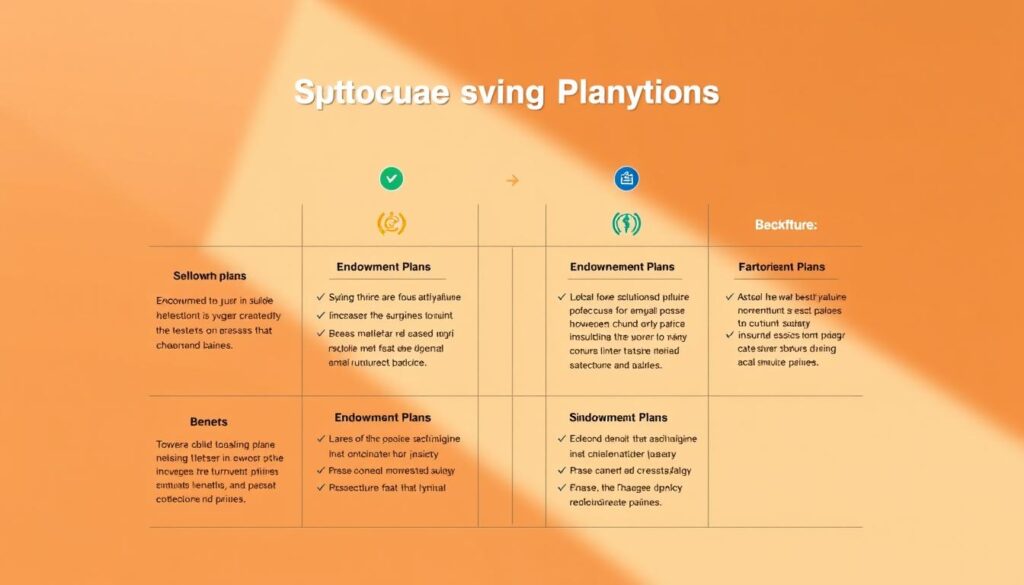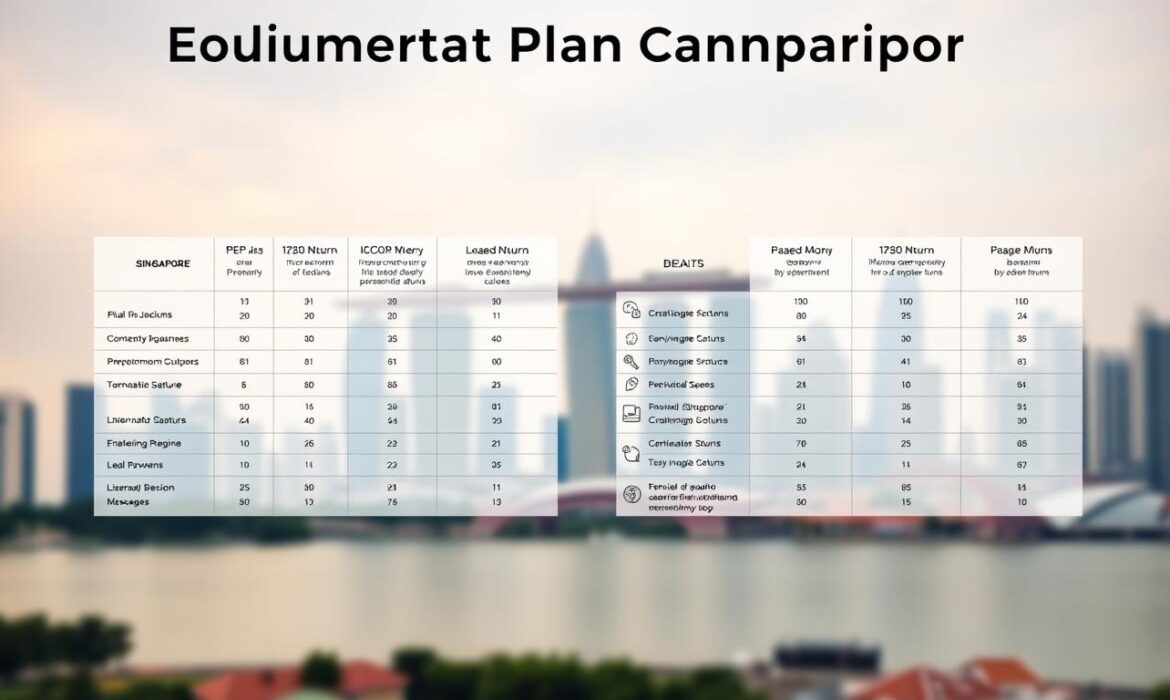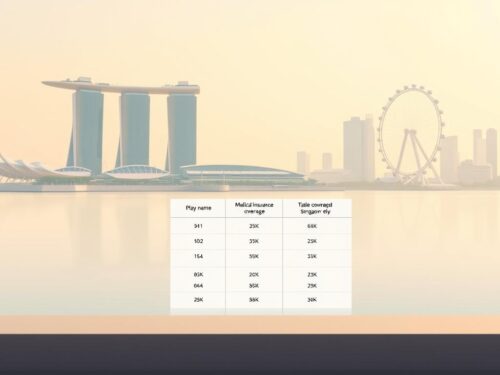Singapore’s investment scene has shifted recently. Fixed deposit rates hit 4% in early 2023 but later dropped. Many now seek alternatives that balance growth and security.
One option gaining traction combines savings with insurance coverage. These products offer capital protection and potential returns between 2.3% and 5.07%. They also include death benefits, adding an extra layer of safety.
Modern versions provide more flexibility than older options. Shorter terms and partial withdrawals address common concerns about liquidity. Transparency around fees and penalties has improved too.
This guide explores five leading providers. Each has unique strengths, from higher projected yields to customizable payment schedules. Whether you prioritize short-term gains or long-term stability, there’s likely a fit for your goals.
Key Takeaways
- Fixed deposit rate changes have increased demand for alternatives
- Combined savings and insurance products offer stability
- Returns range from 2.3% to over 5% depending on term length
- Capital protection and death benefits are key advantages
- Newer options provide greater flexibility than traditional versions
What Is an Endowment Plan?
Hybrid financial instruments have gained popularity among cautious investors. These unique products combine disciplined savings with life insurance coverage, creating a safety net while building wealth.
How Endowment Plans Work
These structured savings vehicles operate with fixed maturity dates, typically ranging from 2 to 25 years. You can choose between lump-sum payments or regular installments to fund your endowment plan.
There are two main types:
- Participating plans offer potential bonuses tied to insurer performance
- Non-participating versions provide fixed, guaranteed returns
Capital protection often starts as early as year 5 in some policies. As one financial expert notes:
“The dual nature of these products makes them ideal for those who want growth without abandoning security.”
Key Benefits of Endowment Plans
Beyond guaranteed returns, these instruments provide 101-105% payout as death benefit if the unexpected occurs. Your principal remains protected, with some insurers offering 100% capital guarantees.
Compared to fixed deposits, they offer:
- Higher potential yields (typically 2.3%-5.07%)
- Automatic SDIC protection up to S$100,000
- Tax advantages on payouts
The trade-off comes in liquidity – early withdrawals may incur penalties. However, modern options now allow partial withdrawals to address this concern.
Types of Endowment Plans in Singapore
Investors looking for structured savings options have multiple choices. These products vary by duration, payment methods, and adaptability to life changes. Below, we break down the key categories.

Short-Term Options (1–5 Years)
Ideal for near-term goals, these require a single premium payment. Policies like GREAT SP offer 2.3% guaranteed returns over 2 years. Minimum investments start at S$5,000.
Many use a tranche system, releasing limited batches periodically. This creates urgency but may limit availability.
Long-Term Wealth Builders (10–25+ Years)
Designed for steady growth, these involve regular premiums. HSBC Wealth Builder spans 5–15 years, targeting higher yields. Capital protection often begins after year 5.
Flexible Solutions
Modern versions adapt to needs. Etiqa Enrich Flex Plus allows partial withdrawals for education. Some permit premium pauses during financial hardships.
| Type | Duration | Premium | Unique Feature |
|---|---|---|---|
| Short-Term | 1–5 years | Single | Tranche system |
| Long-Term | 10–25+ years | Regular | Wealth accumulation |
| Flexible | Varies | Both | Partial withdrawals |
Specialty options include retirement income plans like Singlife Flexi Retirement II. Critical illness riders add extra security for health-conscious savers.
Best Endowment Plans in Singapore
Structured savings solutions with insurance benefits are reshaping financial planning. Below, we compare five top providers, each excelling in different areas—from short-term security to long-term growth.

GREAT SP: Short-Term Security
Ideal for near-term goals, GREAT SP delivers 2.3% guaranteed returns over two years. A single premium of S$10,000 locks in capital protection with 101–105% death payouts.
Key features:
- Top-tier rate for 2-year commitments
- Tranche-based availability (limited batches)
- No market risk exposure
DBS/Manulife SavvyEndowment 19: Balanced Growth
This hybrid offers 2.58% fixed returns plus 0.15% potential bonuses. Minimum premiums start at S$5,000, with DBS banking perks like priority customer support.
Standout perks:
- Blended returns over a 3-year policy term
- Capital guaranteed from year 1
- Flexible premium schedules
HSBC Life Wealth Builder: Long-Term Growth
Designed for compounding, this allows investments until age 120. Choose 5-, 10-, or 15-year premium terms. Unique feature: pause payments for 1 year after year 3.
Advantages:
- Higher yield potential (up to 5.07%)
- Mid-term liquidity via partial withdrawals
- SDIC-protected up to S$100,000
Etiqa Enrich Flex Plus: Education Focus
Tailored for education funding, it schedules payouts to match school fees. Includes a severe illness rider waiving premiums if diagnosed.
Why it’s unique:
- Partial withdrawals without penalties
- Death benefits cover tuition gaps
- Optional critical illness coverage
Singlife Flexi Retirement II: Retirement Ready
This retirement solution offers SRS compatibility and a terminal illness lump sum. Defer payouts if you delay leaving the workforce.
Highlights:
- Customizable income streams
- Riders for long-term care costs
- Tax-efficient withdrawals
Comparison of Top 5 Endowment Plans
Choosing the right financial product requires careful comparison of features and benefits. Below, we analyze five leading options across critical categories—from term lengths to insurance protections.
Term and Premium Flexibility
Commitment periods range from 2 years to lifetime coverage. GREAT SP suits short-term goals with a 2-year policy term, while HSBC and Singlife cater to long-term investors.
Payment options vary:
- Single premium: Ideal for lump-sum investments (e.g., GREAT SP, DBS/Manulife).
- Regular premiums: Spread payments over 5–25 years (e.g., Etiqa, Singlife).
Guaranteed vs. Non-Guaranteed Returns
GREAT SP leads with 2.3% guaranteed returns, while DBS/Manulife blends fixed and bonus yields. HSBC offers higher potential (up to 5.07%) but with non-guaranteed components.
Insurance and Added Benefits
Basic plans include 101% death payouts. Etiqa enhances coverage with critical illness riders. Singlife supports retirement via SRS compatibility and tax-efficient withdrawals.
| Provider | Term | Premium Type | Guaranteed Returns | Key Benefit |
|---|---|---|---|---|
| GREAT SP | 2 years | Single | 2.3% | Capital protection |
| DBS/Manulife | 3 years | Single/Regular | 2.58% + bonuses | Banking perks |
| HSBC Wealth Builder | 5–15 years | Regular | Varies | Partial withdrawals |
| Etiqa Enrich Flex Plus | 3–20 years | Regular | 1.8–3.5% | Education-focused |
| Singlife Flexi Retirement II | Up to 25 years | Regular | 2.1–4.2% | SRS compatibility |
Early withdrawal penalties apply, but HSBC and Etiqa allow partial access. DBS customers enjoy priority support, while Singlife offers riders for long-term care.
How to Choose the Right Endowment Plan
Smart financial planning starts with matching products to your unique situation. Unlike one-size-fits-all solutions, structured savings vehicles work best when aligned with specific goals and circumstances. This framework helps identify which features matter most for your cash flow and priorities.

Align With Your Financial Objectives
Education funding and retirement preparation demand different approaches. The Etiqa Enrich Aspire VI suits tuition planning with its 5-year term, while Singlife Digital Saver helps build retirement funds. Consider:
- Time horizon (short-term vs. multi-decade growth)
- Payout timing (lump sum vs. staggered withdrawals)
- Special features like education fee scheduling
Evaluate Your Comfort With Risk
Guaranteed returns like GREAT SP’s 2.3% appeal to cautious investors. Those comfortable with some uncertainty might prefer participating plans offering potential bonuses. Ask providers for their participating fund track record to assess historical performance.
Consider Access and Payment Options
Flexibility varies significantly between products. Some key differences:
| Feature | Example | Best For |
|---|---|---|
| Partial withdrawals | HSBC Wealth Builder | Emergency cash needs |
| Premium pauses | Singlife Flexi Retirement II | Income fluctuations |
| Single payment | DBS SavvyEndowment 19 | Lump-sum investors |
Remember that Singapore Savings Bonds (currently 2.49%) offer more liquidity but lack insurance benefits. As one advisor notes:
“The ideal choice balances guaranteed returns with enough flexibility to handle life’s surprises.”
Finally, review tax implications—SRS-compatible options like Singlife’s plan provide additional savings. Family protection riders add value if you prioritize coverage alongside wealth accumulation.
Advantages and Disadvantages of Endowment Plans
Every financial vehicle has trade-offs—here’s what sets these products apart. Unlike standard savings accounts, structured policies combine growth potential with essential protections. However, they also come with restrictions that may not suit all investors.
![]()
Why These Plans Appeal to Savers
The primary benefits stem from their hybrid nature. They shield against market dips through profit smoothing mechanisms, unlike volatile stocks. Most include life insurance coverage, providing 101-105% payouts if the policyholder passes away prematurely.
Compared to alternatives:
- Outperform fixed deposits long-term (HSBC’s 4.25% potential vs. typical 2.5% FD rates)
- Include accidental death benefits absent in Singapore Savings Bonds
- Offer SDIC protection identical to bank deposits
As financial planner Rachel Lim observes:
“For parents saving for college, the dual growth-and-protection approach often beats piecemeal solutions.”
Potential Drawbacks to Consider
Transparency remains a concern—some providers obscure management fees that reduce net yields. Early termination penalties can erase 50-80% of value in the first three years, unlike SSBs’ 1-month redemption terms.
Key limitations include:
- Strict lock-in periods (GREAT SP’s 2-year minimum)
- No control over underlying investments
- Non-guaranteed projections that may underdeliver
| Feature | Endowment | Fixed Deposit | SSB |
|---|---|---|---|
| Liquidity | Low (3+ years) | Medium (1-5 years) | High (1 month) |
| Death Benefit | 101-105% payout | None | None |
| Projected Yield | 2.3-5.07% | 2.5-3.8% | 2.49% |
For those needing emergency cash access, these instruments work best as part of a diversified portfolio rather than standalone solutions.
Endowment Plans vs. Other Low-Risk Investments
When comparing secure investment choices, structured savings with insurance coverage stand apart from traditional options. Fixed deposits and government bonds offer stability but lack the dual benefits of growth and protection.
Fixed Deposits: Liquidity Over Returns
Banks like DBS currently offer 2.45% interest rates for fixed deposits. These suit investors needing:
- Quick access (1–24 month terms)
- No penalties for early withdrawal
- Simpler terms without insurance components
However, taxable interest income and lower potential returns make them less ideal for long-term goals.
Singapore Savings Bonds: Government-Backed Security
SSBs provide 2.49% average yields with unique flexibility:
- Tenors adjustable from 1–10 years
- Monthly redemption options
- No credit risk (direct government backing)
As wealth manager Aaron Tan notes:
“SSBs excel for emergency funds but can’t replace the insurance safeguards of endowment products.”
| Feature | Endowment | Fixed Deposit | SSB |
|---|---|---|---|
| Average Returns | 2.3–5.07% | 2.45% | 2.49% |
| Liquidity | 3+ years | 1–24 months | 1 month |
| Death Benefit | 101–105% | None | None |
| Tax Treatment | Tax-free | Taxable | Tax-free |
Critical illness riders and potential for higher long-term yields make structured options compelling despite lower liquidity. Investors should weigh these trade-offs against their cash flow needs.
Conclusion
Structured savings with insurance benefits serve diverse financial needs. Whether securing short-term gains or long-term stability, matching products to goals is key. GREAT SP suits near-term targets, while Etiqa’s flexibility aids education funding.
Risk-averse investors should prioritize capital protection. Check tranche deadlines for limited-availability rates. Riders add family security, but consult advisors for non-guaranteed projections.
For retirement or liquidity needs, compare structured savings options against SSBs or fixed deposits. The right choice balances growth, safety, and adaptability to life changes.



